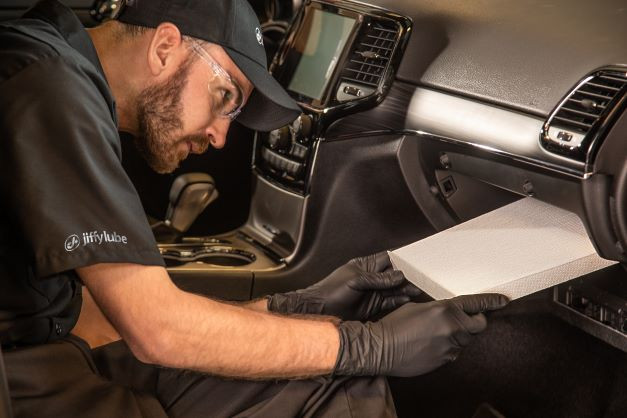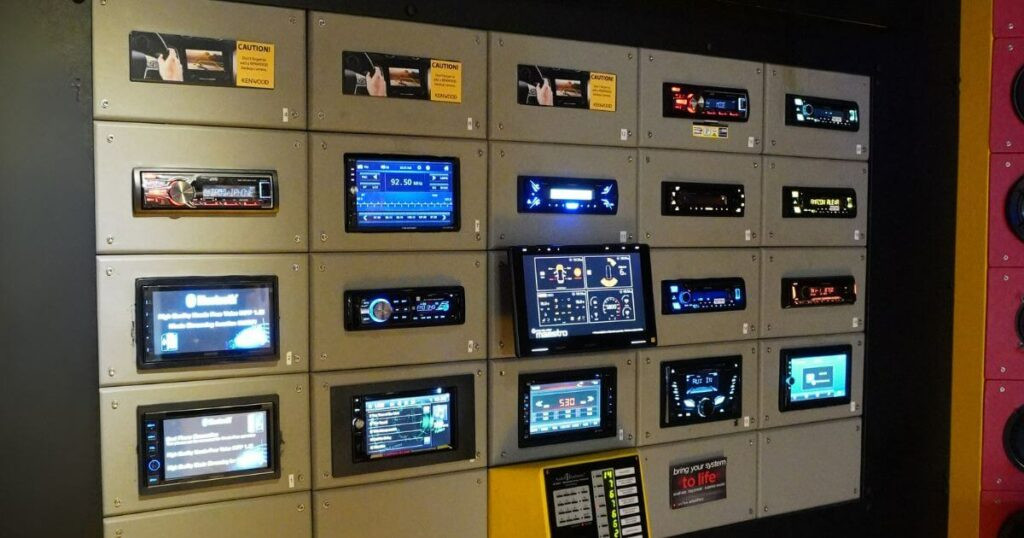Where To Fix Car AC Near Me: Your Ultimate Guide

Is your car AC blowing hot air? Finding “where to fix car ac near me” is crucial for staying comfortable on the road. CARDIAGTECH.NET provides expert insights and solutions to keep your vehicle’s air conditioning running smoothly, ensuring a cool and pleasant driving experience. Learn about car AC repair costs, common issues, and preventative maintenance to keep your system in top shape, enhancing your vehicle’s performance and your comfort.
1. Understanding Your Car’s AC System
The car’s air conditioning system, technically known as HVAC (Heating, Ventilation, and Air Conditioning), does more than just blow cold air. It manages refrigerant from gas to liquid, controlling temperature and air quality inside the vehicle. Knowing how the HVAC system works helps you understand why it might fail and what repairs it might need.
1.1. Key Components of the HVAC System
Here’s a breakdown of the essential parts of the HVAC system:
- Compressor: Driven by a belt connected to the crankshaft, the compressor uses pistons to compress refrigerant gas, creating heat and high pressure.
- Condenser: This component cools the heated, pressurized gas, transforming it into a liquid.
- Dryer: The dryer ensures no gas remains as the liquid refrigerant flows towards the control device.
- Flow Control Device: This device (such as a thermal expansion valve or orifice tube) regulates the flow of liquid refrigerant to the evaporator.
- Evaporator: Here, the liquid refrigerant absorbs heat from inside the car, turning back into a gas.
- Fan: The fan blows air, either from outside or recirculated from inside the car, through the evaporator to cool the cabin.
 Car AC compressor working to compress refrigerant gas
Car AC compressor working to compress refrigerant gas
1.2. Why Proper Refrigerant Levels Matter
For your AC to work efficiently, it must be free of contaminants and have the correct amount of refrigerant. Low refrigerant levels can lead to poor cooling performance and potential damage to other components. Regular maintenance can help prevent these issues and ensure your AC system operates at its best.
2. Common Car AC Problems and Their Costs
Several factors can cause your car’s AC to malfunction. Understanding these issues can help you better estimate the cost to fix your AC. Let’s explore some common problems and their typical repair costs.
2.1. Refrigerant Leaks
The AC system operates under high pressure, making tight seals crucial. Although a small refrigerant leak (less than an ounce per year) is normal, significant leaks can cause major problems. These leaks often occur due to pressure, heat, and age affecting the sealing materials.
- O-Ring Replacement: If the O-rings are leaking, replacing them is necessary. While O-rings are inexpensive (around $10 for a pack), the labor costs can increase the overall price because the system needs depressurization and evacuation.
- Compressor Damage: Running the compressor with low refrigerant for an extended period can cause it to fail, requiring replacement. Compressors are more expensive than O-rings, significantly raising repair costs.
2.2. Faulty Compressor
A malfunctioning compressor can cause several symptoms, including a lack of cool air, unusual noises, and fluid leaks.
- Compressor Replacement: Replacing a compressor requires specialized tools and a trained technician. The process can be labor-intensive, adding to the overall cost. According to RepairPal, the average AC compressor replacement cost ranges from $761 to $946, including parts and labor.
2.3. Dirty Cabin Air Filter
Insufficient airflow from the AC ducts, along with dust, pollen, and pollutants entering the car, may indicate a clogged cabin air filter.
- Cabin Air Filter Replacement: It’s recommended to replace the cabin air filter every 15,000 to 30,000 miles, as specified in your vehicle owner’s manual. In many cases, this can be a quick DIY job, but you can also have it done at a service center. Jiffy Lube lists cabin air filter replacement services as part of their maintenance offerings.
2.4. Other Component Issues
The HVAC system contains numerous components (evaporator, condenser, dryer, etc.) that may require repair or replacement.
- Component Servicing: Each component must be serviced carefully with professional tools to avoid contamination of the entire system. Repair or replacement of these parts can be labor-intensive and costly.
2.5. Cost Overview Table
| Repair Type | Description | Average Cost (USD) |
|---|---|---|
| O-Ring Replacement | Replacing leaking O-rings; requires system depressurization and evacuation. | $50 – $200 |
| AC Compressor Replacement | Replacing a faulty compressor; labor-intensive and requires specialized tools. | $761 – $946 |
| Cabin Air Filter Replacement | Replacing a clogged cabin air filter to improve airflow and air quality. | $30 – $70 |
| Component Servicing | Repair or replacement of other AC components like evaporator, condenser, or dryer. | $200 – $1000+ |
| AC Recharge | Refilling the refrigerant in the AC system to restore cooling performance. | $100 – $300 |
These costs can vary based on your location, the make and model of your vehicle, and the specific repair shop you choose.
3. Finding Reliable Car AC Repair Services Near You
When searching for “where to fix car ac near me,” it’s essential to find a reputable service provider. Here’s how to ensure you choose the best option.
3.1. Online Search and Reviews
- Google Search: Use search engines like Google to find local auto repair shops. Enter specific queries such as “car AC repair [your city]” or “best auto AC service near me.”
- Review Platforms: Check online review platforms like Yelp, Google Reviews, and the Better Business Bureau to gauge the quality and reliability of different service providers. Pay attention to the number of reviews, the overall rating, and the details of customer experiences.
3.2. Ask for Recommendations
- Personal Network: Ask friends, family, and colleagues for recommendations. Personal referrals can provide valuable insights into the quality of service and customer satisfaction.
- Online Forums and Groups: Participate in online forums and social media groups related to cars and local communities. Ask for recommendations and advice from other car owners in your area.
3.3. Check for Certifications and Affiliations
- ASE Certification: Look for technicians who are certified by the National Institute for Automotive Service Excellence (ASE). ASE certification indicates that the technician has met specific standards of knowledge and competence.
- Professional Affiliations: Check if the repair shop is affiliated with reputable industry organizations like the Automotive Service Association (ASA). Membership in these organizations often signifies a commitment to quality and professionalism.
3.4. Evaluate the Shop’s Reputation
- Cleanliness and Organization: A well-maintained and organized shop often indicates a higher level of professionalism and attention to detail.
- Customer Service: Pay attention to how the staff treats you. Are they friendly, helpful, and willing to answer your questions? Good customer service is a sign of a reputable business.
- Warranty and Guarantees: Ask about the shop’s warranty policy. A reputable shop should offer a warranty on their parts and labor, providing you with peace of mind.
3.5. Get a Detailed Estimate
- Comprehensive Inspection: A reliable shop will perform a thorough inspection of your AC system before providing an estimate. This inspection should identify the root cause of the problem and any additional issues that need to be addressed.
- Written Estimate: Always get a written estimate that includes a breakdown of the costs for parts and labor. This will help you understand the total cost of the repair and avoid any surprises.
- Compare Estimates: Get estimates from multiple shops to compare prices and services. Be wary of estimates that are significantly lower than others, as this may indicate lower quality parts or inexperienced technicians.
3.6. Tools and Equipment
When it comes to fixing your car’s AC, having the right tools and equipment is paramount. CARDIAGTECH.NET offers a wide range of high-quality tools that can help technicians diagnose and repair AC issues efficiently.
3.6.1. Key Diagnostic Tools
- Manifold Gauge Set: This tool is essential for measuring the pressure in the AC system. It helps technicians determine if the refrigerant levels are correct and identify any leaks.
- Electronic Leak Detector: This device detects refrigerant leaks quickly and accurately, even in hard-to-reach areas.
- UV Dye and Light: UV dye is injected into the AC system, and a UV light is used to find leaks. This method is particularly useful for small, difficult-to-detect leaks.
- Thermometer: A reliable thermometer is necessary for checking the temperature of the air coming from the AC vents. This helps technicians assess the cooling performance of the system.
3.6.2. Essential Repair Equipment
- Vacuum Pump: This tool removes air and moisture from the AC system before recharging it with refrigerant. A vacuum pump is crucial for ensuring the system operates efficiently and preventing damage.
- Refrigerant Recovery Machine: This machine safely removes and stores refrigerant from the AC system. It is essential for complying with environmental regulations and preventing the release of harmful substances into the atmosphere.
- Refrigerant Recharging Station: This station accurately measures and refills the AC system with the correct amount of refrigerant. It ensures the system operates at its optimal performance.
- AC Flush Machine: This machine cleans the AC system by removing contaminants, such as oil, debris, and moisture. Flushing the system can improve cooling performance and extend the life of the AC components.
3.7. Utilizing CARDIAGTECH.NET for Your Repair Needs
CARDIAGTECH.NET offers a variety of tools and equipment that are essential for diagnosing and repairing car AC systems. Investing in high-quality tools can improve the efficiency and accuracy of your repairs, leading to better customer satisfaction and increased profits.
Contact CARDIAGTECH.NET at +1 (641) 206-8880 or visit our location at 276 Reock St, City of Orange, NJ 07050, United States for expert advice and to purchase the best tools for your auto repair needs.
4. Step-by-Step Guide to AC Recharge
Recharging your car’s AC involves replenishing the refrigerant to ensure optimal cooling performance. Here’s a detailed step-by-step guide on how to do it:
4.1. Gather Necessary Tools and Materials
- Refrigerant: Purchase the correct type of refrigerant for your vehicle. Refer to your owner’s manual or the sticker under the hood to identify the appropriate type (e.g., R-134a or R-1234yf).
- Recharge Kit: Buy a recharge kit that includes a charging hose, gauge, and can tap.
- Safety Glasses and Gloves: Protect your eyes and hands from refrigerant exposure.
- Wrench: You may need a wrench to tighten the can tap.
- Vehicle’s AC System Diagram: Familiarize yourself with the location of the low-pressure service port.
4.2. Prepare the Vehicle
- Park in a Well-Ventilated Area: Ensure you are working in a well-ventilated area to avoid inhaling refrigerant fumes.
- Turn on the Engine: Start the engine and turn on the AC to the maximum cooling setting with the fan on high.
- Locate the Low-Pressure Service Port: The low-pressure service port is usually located on the larger of the two AC lines. It often has a cap marked with an “L.”
4.3. Connect the Recharge Kit
- Attach the Charging Hose: Connect the charging hose from the recharge kit to the low-pressure service port. The connector should snap into place.
- Prepare the Refrigerant Can: Attach the can tap to the refrigerant can and gently pierce the can according to the kit’s instructions.
4.4. Recharge the AC System
- Check the Gauge Reading: Monitor the pressure gauge on the charging hose. The ideal pressure range is typically between 25-45 PSI, but refer to your vehicle’s specific requirements.
- Add Refrigerant: Hold the refrigerant can upright and slowly squeeze the trigger or turn the valve to release refrigerant into the system. Watch the gauge to ensure you don’t overcharge.
- Rock the Can Gently: Occasionally rock the can gently to help the refrigerant flow into the system.
- Monitor the Cooling Performance: Check the air temperature coming from the AC vents. It should start to cool down as you add refrigerant.
4.5. Final Steps
- Disconnect the Charging Hose: Once the gauge reads within the recommended range and the AC is blowing cold air, disconnect the charging hose from the low-pressure service port.
- Replace the Service Port Cap: Securely replace the cap on the low-pressure service port.
- Monitor the System: Observe the AC performance over the next few days to ensure it continues to blow cold air. If the issue persists, there may be a larger problem, such as a leak, that requires professional attention.
4.6. Safety Precautions
- Wear Safety Gear: Always wear safety glasses and gloves to protect yourself from refrigerant exposure.
- Avoid Overcharging: Overcharging the AC system can damage the compressor and other components. Monitor the gauge carefully and add refrigerant slowly.
- Proper Disposal: Dispose of empty refrigerant cans properly according to local regulations.
- Professional Help: If you are uncomfortable performing this procedure or if the problem persists, seek help from a qualified AC technician.
5. Benefits of Regular AC Maintenance
Regular maintenance of your car’s AC system can prevent costly repairs and ensure consistent performance. Here are some key benefits:
5.1. Prevents Costly Repairs
- Early Detection: Regular inspections can identify minor issues before they escalate into major problems. For example, detecting and fixing a small refrigerant leak early can prevent compressor damage.
- Component Longevity: Keeping the system clean and properly lubricated can extend the life of critical components like the compressor, evaporator, and condenser.
5.2. Improves Cooling Efficiency
- Optimal Refrigerant Levels: Maintaining the correct refrigerant levels ensures the AC system cools efficiently. Low refrigerant levels can reduce cooling performance and increase energy consumption.
- Clean Air Filters: Regularly replacing the cabin air filter ensures proper airflow, allowing the AC system to cool the cabin more effectively.
5.3. Enhances Air Quality
- Removes Pollutants: The cabin air filter traps dust, pollen, and other pollutants, improving the air quality inside the vehicle. This is particularly beneficial for individuals with allergies or respiratory issues.
- Reduces Odors: A clean AC system prevents the buildup of mold and bacteria, which can cause unpleasant odors. Regular maintenance helps keep the air inside your car fresh and clean.
5.4. Increases Fuel Efficiency
- Reduced Load on Engine: An efficiently operating AC system places less load on the engine, which can improve fuel efficiency. When the AC system is not working correctly, the engine has to work harder to provide cooling, resulting in increased fuel consumption.
5.5. Ensures Consistent Performance
- Reliable Cooling: Regular maintenance ensures that the AC system operates reliably, providing consistent cooling performance even in hot weather.
- Comfortable Driving Experience: A well-maintained AC system contributes to a more comfortable and enjoyable driving experience for both the driver and passengers.
5.6. Maintenance Tips
- Regular Inspections: Have your AC system inspected at least once a year by a qualified technician.
- Check Refrigerant Levels: Monitor the refrigerant levels and recharge the system as needed.
- Replace Cabin Air Filter: Replace the cabin air filter every 15,000 to 30,000 miles, or more frequently if you drive in dusty or polluted conditions.
- Clean Condenser Fins: Keep the condenser fins clean to ensure proper airflow and cooling efficiency.
- Run AC Regularly: Operate the AC system regularly, even in cooler months, to keep the components lubricated and prevent them from drying out.
6. Why Choose CARDIAGTECH.NET for Your AC Repair Needs?
When searching for “where to fix car ac near me,” consider CARDIAGTECH.NET for our commitment to quality, expertise, and customer satisfaction.
6.1. Expertise and Experience
- Skilled Technicians: Our technicians are highly trained and experienced in diagnosing and repairing all types of AC issues. They stay up-to-date with the latest technologies and techniques to provide you with the best possible service.
- Comprehensive Knowledge: We have a thorough understanding of AC systems and can accurately identify and resolve any problem, from minor leaks to major component failures.
6.2. State-of-the-Art Equipment
- Advanced Diagnostic Tools: We use the latest diagnostic equipment to accurately assess the condition of your AC system and identify the root cause of any problems.
- High-Quality Repair Tools: Our repair tools are of the highest quality, ensuring that all repairs are performed efficiently and effectively.
6.3. Quality Parts and Refrigerants
- OEM and Aftermarket Parts: We use only high-quality OEM (Original Equipment Manufacturer) and aftermarket parts that meet or exceed industry standards.
- Environmentally Friendly Refrigerants: We use environmentally friendly refrigerants that comply with all applicable regulations.
6.4. Transparent Pricing
- Detailed Estimates: We provide detailed estimates before starting any work, so you know exactly what to expect.
- No Hidden Fees: Our pricing is transparent, with no hidden fees or surprises.
6.5. Customer Satisfaction
- Friendly Service: We are committed to providing friendly, professional service that exceeds your expectations.
- Warranty on Repairs: We stand behind our work with a warranty on all repairs, giving you peace of mind.
6.6. Convenient Location and Hours
- Easily Accessible: Our shop is conveniently located at 276 Reock St, City of Orange, NJ 07050, United States, making it easy for you to drop off and pick up your vehicle.
- Flexible Hours: We offer flexible hours to accommodate your busy schedule.
7. Addressing the Challenges of Auto Repair
Auto repair, especially AC repair, presents several challenges. CARDIAGTECH.NET is dedicated to helping technicians overcome these hurdles with quality tools and expert support.
7.1. Physical Demands
- Strain and Fatigue: Auto repair can be physically demanding, requiring technicians to work in awkward positions and lift heavy parts. This can lead to strain and fatigue.
- CARDIAGTECH.NET Solutions: We offer ergonomic tools and equipment that are designed to reduce strain and improve comfort, allowing technicians to work more efficiently and safely.
7.2. Exposure to Hazardous Materials
- Chemical Contact: Technicians are frequently exposed to hazardous materials such as oils, solvents, and refrigerants. Prolonged exposure can cause skin irritation, respiratory problems, and other health issues.
- CARDIAGTECH.NET Solutions: We provide safety equipment such as gloves, masks, and ventilation systems to protect technicians from hazardous materials.
7.3. Keeping Up with Technology
- Constant Learning: The automotive industry is constantly evolving, with new technologies and systems being introduced regularly. Technicians must stay up-to-date with the latest advancements to remain competitive.
- CARDIAGTECH.NET Solutions: We offer training and resources to help technicians keep up with the latest technologies. Our tools are designed to be user-friendly and intuitive, making it easier to diagnose and repair modern vehicles.
7.4. Time Constraints
- Tight Deadlines: Auto repair shops often operate under tight deadlines, requiring technicians to work quickly and efficiently.
- CARDIAGTECH.NET Solutions: Our high-quality tools and equipment can help technicians work faster and more accurately, reducing repair times and increasing productivity.
7.5. Competition
- Market Saturation: The auto repair industry is highly competitive, with numerous shops vying for the same customers.
- CARDIAGTECH.NET Solutions: We offer tools and equipment that can help your shop stand out from the competition. By investing in high-quality tools, you can provide better service, attract more customers, and increase your profitability.
8. Call to Action
Is your car’s AC not blowing cold air? Don’t suffer through another hot day. Contact CARDIAGTECH.NET today for expert AC repair services. Our skilled technicians, state-of-the-art equipment, and commitment to customer satisfaction make us the best choice for all your auto repair needs.
Contact us at +1 (641) 206-8880 or visit our location at 276 Reock St, City of Orange, NJ 07050, United States. Let CARDIAGTECH.NET help you stay cool on the road!
9. Frequently Asked Questions (FAQ)
9.1. How often should I recharge my car’s AC?
It is generally recommended to recharge your car’s AC every 2-3 years. However, if you notice a decrease in cooling performance, it may be necessary to recharge it sooner.
9.2. What are the signs that my car’s AC needs repair?
Common signs include blowing warm air, unusual noises when the AC is turned on, a musty odor coming from the vents, and a visible leak.
9.3. Can I recharge my car’s AC myself?
Yes, you can recharge your car’s AC yourself with a recharge kit. However, it is important to follow the instructions carefully and wear safety gear. If you are not comfortable performing this procedure, it is best to seek professional help.
9.4. How much does it cost to fix a refrigerant leak?
The cost to fix a refrigerant leak can vary depending on the location and severity of the leak. Minor leaks, such as those from O-rings, may cost between $50 and $200 to repair. More significant leaks, such as those from the evaporator or condenser, may cost between $200 and $1000 or more.
9.5. What is the difference between R-134a and R-1234yf refrigerants?
R-134a is an older type of refrigerant that has been phased out in many new vehicles due to its environmental impact. R-1234yf is a newer, more environmentally friendly refrigerant that is used in most new cars.
9.6. How can I improve the efficiency of my car’s AC?
To improve the efficiency of your car’s AC, make sure to keep the cabin air filter clean, park in the shade when possible, and have the system inspected regularly by a qualified technician.
9.7. What are the benefits of using OEM parts for AC repair?
OEM parts are designed to meet the exact specifications of your vehicle, ensuring optimal performance and reliability. While they may be more expensive than aftermarket parts, they can often provide a longer lifespan and better overall value.
9.8. How can I find a reputable AC repair shop near me?
To find a reputable AC repair shop near you, check online reviews, ask for recommendations from friends and family, and look for shops with ASE-certified technicians.
9.9. What should I expect during an AC inspection?
During an AC inspection, the technician will visually inspect the components for cracks, leaks, and damage, check the operation of the compressor, test the function of the compressor and other AC components, and measure the refrigerant levels.
9.10. What is the warranty on AC repairs from CARDIAGTECH.NET?
CARDIAGTECH.NET offers a warranty on all AC repairs, giving you peace of mind. Contact us for specific details on our warranty policy.
By addressing these FAQs, we aim to provide comprehensive information to help you maintain your car’s AC system and make informed decisions about repairs. At CARDIAGTECH.NET, we are dedicated to providing top-notch service and ensuring your satisfaction.







